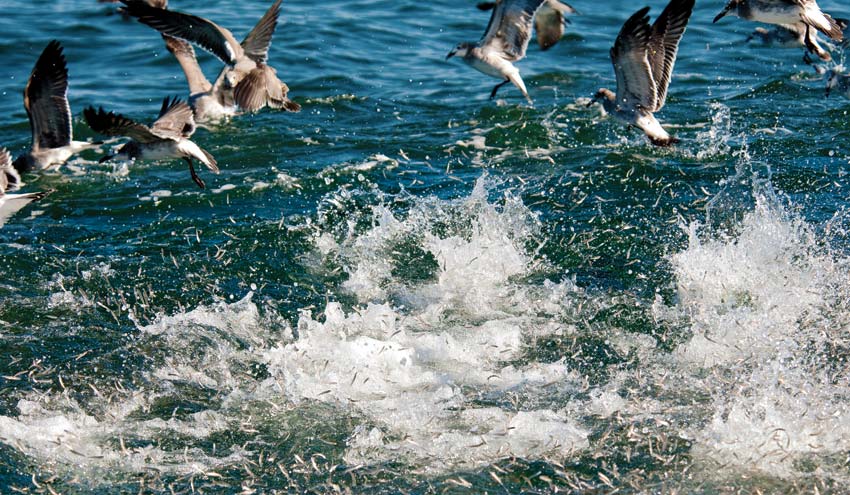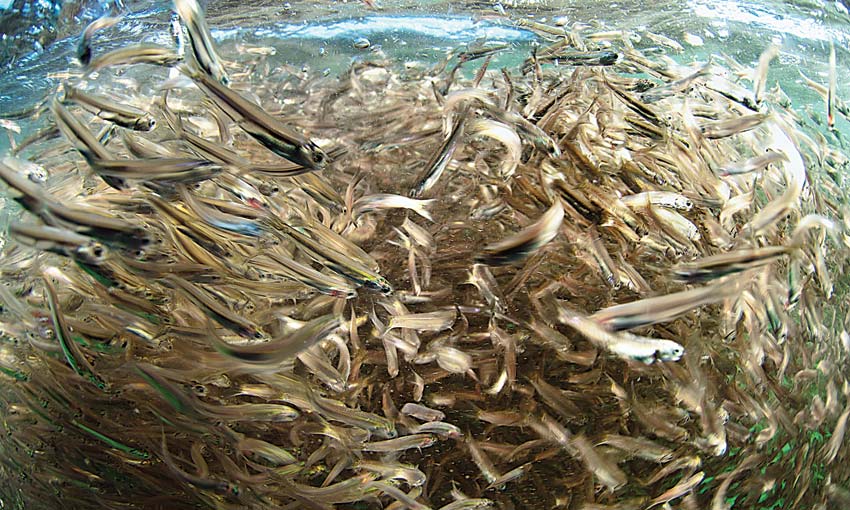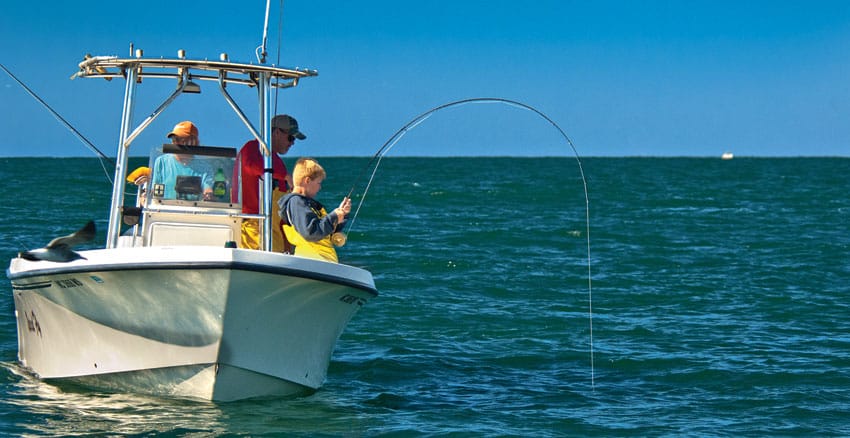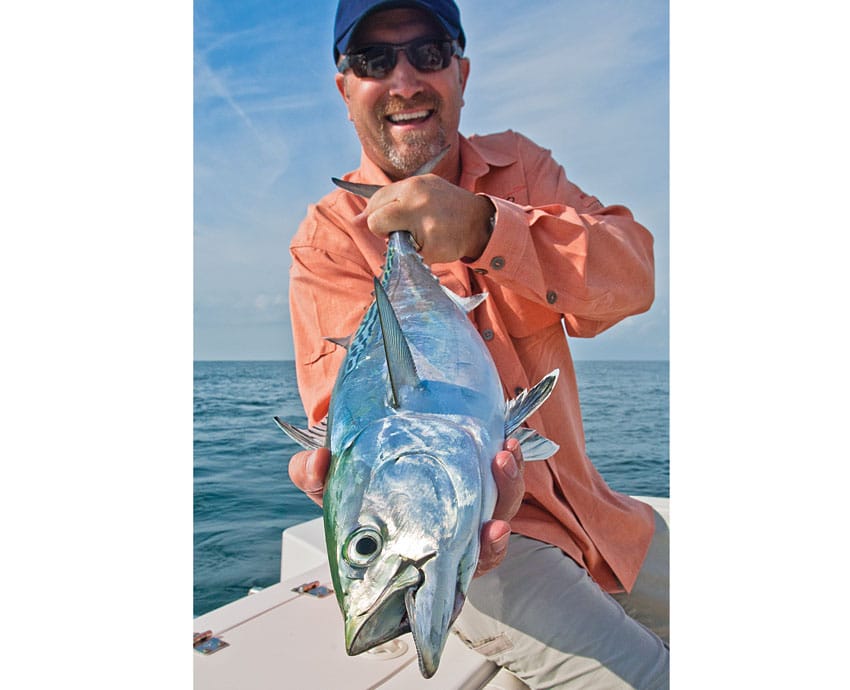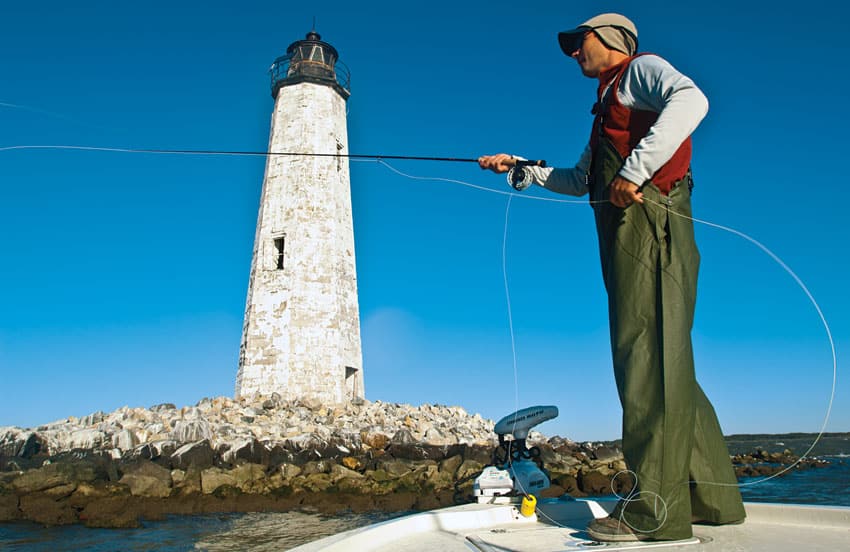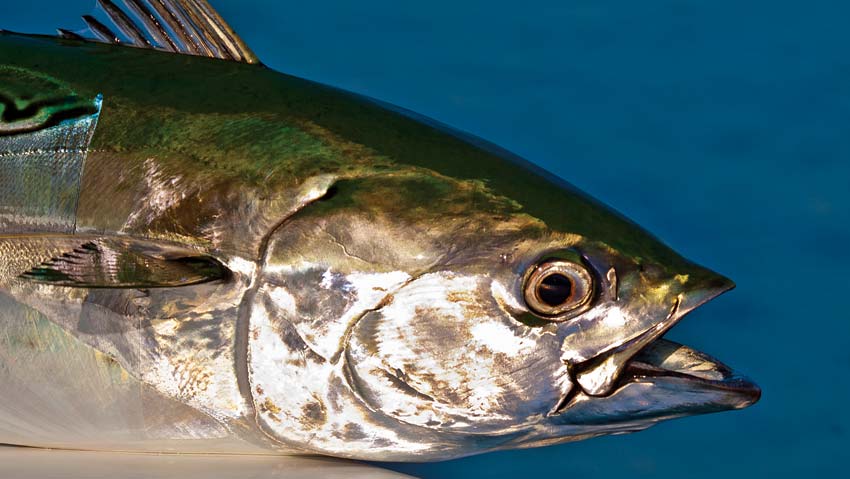
Years ago, a co-worker walked up to me on a Monday morning and asked, “What is it that you guys like so much about catching false albacore?” An avid and accomplished angler, but not a fly-fisher, he was just back from a weekend of slow-trolling live bait for king mackerel off the North Carolina coast. He proceeded to explain that “those danged albacore kept grabbing our baits, they strip out a mile of line, and they take forever to get in.”
I asked, “So exactly what are you complaining about?” He looked at me quizzically, as if everyone should know, and said, “They’re no good to eat!” And in fact, that was pretty much the reputation of albies among sport fishers. The book on false albacore was that they made great baits for big billfish and that newbies could toss a spoon at them for a tug on a really slow day, but otherwise, they were pretty much trash fish.
The big “duh” came from North Carolina’s Harkers Island, and word spread quickly, in perfect-storm fashion, as a series of fly-fishing notables churned out articles and TV shows. Local angler Tom Earnhardt introduced a number of us to albie fishing, including Lefty Kreh and Flip Pallot, who filmed a Walker’s Cay Chronicles episode on the fishery. Coincidentally, the general boom in fly-fishing spurred even more interest. The fishing truly was better than most anglers could ever imagine, more so because many lacked a suitable frame of reference. How do you compare an 18- to 20-inch rainbow trout caught on 6X tippet with a No. 22 midge to a 12-pound albacore? It’s not a matter of comparing or ranking. It’s that an entirely different and exciting dimension had been added to fly-fishers’ options. And false albacore were moved from the trash bin to the stuff of dreams. You’ll never forget catching your first one, and the thrill of catching the next one rarely diminishes — except perhaps when your arms are aching from pulling on a few too many. Whatever you hear about albie fishing probably isn’t too far from the truth. Realize, however, that the fishing can be boom or bust. The fish are highly mobile and respond quickly to changing conditions.
**
When to Fish**
While many debate the movement patterns of albacore, nobody questions when to fish for them. When the bait is in, anglers stand a better than good chance of encountering albies. Fall is the prime time, and October and November typically give the best numbers.
Under normal weather patterns, as the water cools, baitfish move out of the shallow sounds and tidal creeks into the more temperate nearshore areas. The albacore move inshore to intercept the concentrated bait. Sudden deviations from the norm often put the fish off. Strong fronts that bring sharp temperature drops or heavy rain and wind that dirty the water can scatter the bait and push the albies away from nearshore areas. For those hiring a guide for a trip, book early and keep your fingers crossed for cooperative conditions.
Finding Fish
An attractive aspect of fly-fishing for albies is the visual nature of the fishery. Below, on and even above the surface, albies, glass minnows and birds create a tornado-like frenzy that can be spotted from far away. Looking for birds, breaking fish and showering bait is the standard recommendation — and a good one at that. When albacore enter the scene, baitballs get pushed to the surface, and the birds always find these. Look for other boats too, and listen to your radio. You’ll have to disregard the idle chatter and occasional misdirection reports, but many use radios to share fishing information.
Some say fishing the tides and/or structures that produce current makes a difference. While that could very well be so, I think what helps the fishing the most is when conditions allow bait to concentrate or, at least, don’t encourage bait to disperse. Temperature and temperature gradients concentrate bait, starting with the general outflow of bait from sounds and marshes in the fall. Tides and wind can cause currents that concentrate bait, as can land masses and depth changes. But albacore aren’t structure-oriented; they are food-oriented.
If your boat has a fish finder, turn it on. Some think this device spooks the fish, but it also helps you find them. A lack of birds or surface feeding doesn’t mean the albacore aren’t there. They simply might be feeding subsurface. It’s another tool in the box.
On the Move
Biologists have classified false albacore as a highly migratory species, an apt description of their here-one-second, gone-the-next feeding pattern and, for that matter, their general movement pattern. Albacore’s movements provide no end of excitement and frustration. Few visual experiences match the sight of a school of albacore slashing through a baitball with the speed and agility of an F-16. That same speed can frustrate anglers and guides when attempting to maneuver the boat for a cast. And even without adding in the weather vagaries mentioned earlier, this explains why fish that were so abundant in a place one day are miles away the next day.
First-timers, and even experienced hands who have been off the water for some time, can be frustrated easily by not understanding the adjustments necessary to deal with all this movement — truthfully, I’m guilty myself. Rick Pope of Temple Fork Outfitters and I were fishing near Cape Lookout, North Carolina, last fall with Capt. Jake Jordan. He was headquartered in the Florida Keys for over three decades, fishing there and all over the world until he decided to “retire” to North Carolina in 2006, in large part because of the albacore fishing. Fishing with him last fall, I made a couple of decent casts but came up empty on each. The fish were clearly eating, and I had no doubt that Jordan’s choice of fly was right on. So I looked at him with a “what am I doing wrong?” face. “You’re stripping, but you’re not moving the fly,” Jordan replied. “Make sure the line is tight after the cast, and make sure you strip the fly fast enough to stay ahead of the boat movement. I saw a fish eat the fly; you just didn’t have the line tight. And don’t cast straight off the bow.” Though knowing better, having been there before, I was too excited by the first opportunity of the season and had focused too much on the fish. I hadn’t given enough thought to adjusting the other variables. After I took advantage of Jordan’s setting up the boat for a cast more quartering or perpendicular to the boat movement, kept my line tight and made sure my fly movement approximated that of the bait, I was in the game. Even experienced anglers get swept up in the moment.
**
Before You Go**
Fly-anglers can attest that windless days don’t come around too often. They also know the ocean moves in and out with the tide and up and down due to the wind. If your boat is not anchored, you almost certainly are moving: drifting forward after the engine is cut or being blown by the wind or carried by the current — somehow, you are in motion.
A tarpon guide told me the best way to prepare for tarpon fishing in the Keys from a staked-out boat was to practice casting while standing in a rocking chair. When fishing for albies, anchoring normally does not apply. That being the case, the best way to practice for this scenario is to cast from a rolling rocking chair.
Seriously, you need to be able to quickly and accurately cast 60 feet or more into the wind, with the wind, or with the wind coming from the left or coming from the right, all while standing on the bow of a bouncing boat — without letting busting albacore distract you. To get the most out of your trip, be prepared before you go. If you’re fishing with a guide, establish your strengths, weaknesses and expectations with him before you set out for the day. That way, the guide can be prepared to work within those capabilities and, if you wish, help you improve.
Making Presentations
With albies, making good casts to busting fish is definitely important, but in order to do so, you’ve got to be able to manage your line. Even small fish will clear the line in a split second, so you’ve got to make sure the line is free from obstructions at all times. After each cast (and during the retrieve when you can), glance down and verify that the line is clear. Adjust the amount of line stripped off the reel so you aren’t leaving loose line on the deck after casting. Leaving line on the deck can get it dirty and twisted, both of which hinder casting distance and efficiency. You can’t catch albacore by casting to their tails. Lead them so that the fly is in front of them — in the meat, as the guides will tell you. When a fish hits, strip-strike and then force yourself to look down and clear the line. You want the fish on the reel and the drag doing its job as soon as possible.
Modern rods, reels, lines and leaders perform their jobs brilliantly these days; however, you can’t use the gear effectively if you’ve never tested its limits. Do you know what 4 pounds of drag set on the reel feels like when the rod is bowed? And do you fight the fish off the rod’s strong butt section or off the tip (known as high-sticking)? Fighting the fish properly isn’t really as much about the rod’s elevation as it is about how and where you control the bend in the rod.
As you get a fish close to the boat, you lose that good angle of pull that really pressures the fish. With a fish right beside the boat, you can quickly be forced into a high-sticking situation, which puts very little pressure on the fish and a great deal of pressure on the rod tip. Separate yourself from the fish to get a better angle. Move to the bow or stern, lighten the drag and be prepared for another quick dash by the fish. If the fish takes you to the stern, be ready to jam the rod tip into the water and clear the boat prop. There are many ways rods get broken albie fishing, but mostly, breakage occurs when an eager angler gets a fish tight against the boat.
Proper Etiquette
As Jordan puts it, this is “share fishing.” There are no set patterns, as is often the case on tarpon flats. The fish move, following the bait, which in turn respond to temperature changes. Thus anglers must find the fish anew every day, and some anglers are head and shoulders above others at finding fish. No one owns the fish or a spot on the ocean, but common courtesy should prevail. Don’t run into a pod of fish or other boats at speed. Slow down and approach quietly. Don’t crowd in and cut off the front or back casting lanes of other boats or interfere with someone fighting a fish. If you’re unsure of the protocol, stay back a few minutes and observe. Better yet, ask before you get on the water. Be respectful; the golden rule applies. Some people just don’t know the rules. Make sure you don’t become “that guy.”
Above all, come prepared to have fun and make memories. There’s no better fish to provide both!
FFSW Tackle Bag
Rods: You’ll want at least two outfits, one rigged for surface and near-surface feeding and a second rigged for deeper fishing. Basically, the rods need to be versatile enough to cast the variety of flies you might be using. Most importantly, the rods need to have stout butt sections to put lots pressure on the fish.
Reels: Large-arbor reels pretty much dominate the scene because of their ability to crank in line fast. Pick one that will hold a floating line of the weight that matches your rod and will accommodate suitable backing (200 yards should be more than enough).
Lines: A selection of floating, intermediate and sinking lines for whichever rods you choose is perhaps the wisest investment you can make. Limited to two lines, I’d go with a clear intermediate (or clear-tip) line and a moderately fast-sinking line.
Leaders: For a basic and easy leader setup, start with a 30- to 50-pound butt section of medium-stiffness nylon or fluorocarbon, plus a 12- to 20-pound tippet. If the jump between butt and tippet is too much for your taste, add a transition section.
Flies: For the most part, albacore don’t appear to be picky eaters. Bring a selection of tiny to medium-size baitfish and glass-minnow patterns tied on stout hooks in chartreuse-and-white and olive-and-white, and you’ll be good to go.
FFSW Planner
The mid-Atlantic coast, specifically North Carolina’s Crystal Coast, as the tourism folks have named it, couldn’t be more perfectly designed for albacore fishing. Centered around Cape Lookout and the nearby towns of Morehead City and Beaufort, this coastal area is geared to strutting its beaches and sights for the hordes of summer tourists.
By the time the fall albacore season arrives, the peak of the tourist season is winding down, and accommodations are easier to find. Morehead City and Beaufort offer a variety of motels, condos and beach houses for rent. Some have boat slips on site or nearby; others don’t. If you want to stay on Harkers Island, the choices in both lodging and food are much more limited.
There are many very good fly-fishing and light-tackle guides in the area. Before you plan your trip, check with any one of these local guides for availability.
**
Capt. George Beckwith**
Down East Guide Service Inc.
252-671-3474
www.pamlicoguide.com
Capt. Gary Dubiel
Spec Fever Guide Service
252-249-1520
www.specfever.com
Capt. Sarah Gardner
Fly Girl Charters
Capt. Brian Horsley
Flat Out Charters
252-449-0562
www.outerbanksflyfishing.com
**
Capt. Rob Pasfield**
Last Cast Charters
252-728-3907
www.harkersmarina.com
Capt. Joe Shute
Fish Finder Charters
800-868-0941
www.captjoes.com
Capt. Jake Jordan
Jake Jordan’s Fishing
Adventures
252-444-3308
www.jakejordan.com
